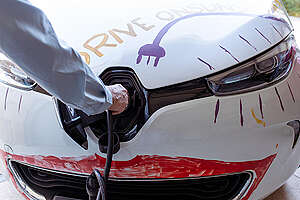The Australian Government has finally agreed to create a fuel efficiency standard to limit pollution from new cars – which is great news for people and the planet and will mean more electric vehicles on our roads and fewer greenhouse gas emissions from cars.

(Catch-up on what a fuel efficiency standard)
Thousands of Greenpeace supporters helped make this happen by lending their voice to our campaign: writing to the Transport Minister, making calls to politicians and even visiting the offices of their local MPs.
But now the tricky bit: the design of the fuel efficiency standard is crucial – if it is too weak or has too many loopholes, it won’t have a meaningful impact on pollution from cars.
We know that is a real risk because the petrol car lobby suggested Australia adopt their voluntary standard a few years ago, which modelling shows would have resulted in no change to business as usual!
The petrol-car lobby is going to keep pushing for weak standards with loopholes you can drive a Hilux through.
But Greenpeace is on the case – you can read our submission to the design process below, where we make the case for a strong fuel efficiency standard which gets Australians into electric vehicles sooner – so we can all enjoy cleaner air, cheaper transport and the transcendent joy of eliminating fossil fuels from our weekly budget.
Executive Summary:
Strong fuel efficiency standards will deliver cost savings for Australian households, healthier communities, quieter streets, new economic opportunities, reduced dependency on foreign oil, and a critical reduction in harmful carbon emissions.
As such Greenpeace Australia Pacific warmly welcomes the government’s commitment to introduce this critical and much overdue policy measure.
In designing these standards Australia can and should benefit from the experience of the many other jurisdictions who have introduced similar standards and have seen the benefits (and pitfalls) realised. This submission identifies the key features which have made those schemes successful – both in reducing emissions from transport and increasing consumer choice and value – and what features should be avoided.
The most important task facing the Government is setting targets and a timeframe for emission reduction which are commensurate with the scale of the climate change challenge, and doing Australia’s fair share. Greenpeace urges the Government to remain steadfast in its commitment to reaching net zero emissions by 2050, which necessitates a shift to all vehicle sales being electric by 2030, or 2035 at the latest. We have no time to lose, and no reason to delay further.
If there is a single principle that defines our submission it is this: simplicity. Design a standard with strong targets, linked to climate science, which catches up to other countries in the short/medium term. Avoid anything which unnecessarily complicates the scheme. Introducing a myriad of flexibilities, credits, technology-specific bonuses etc, only serves to undermine transparency and effectiveness. They are unnecessary given the elegance of a well designed fuel efficiency standard with strong targets.
Finally, consider the needs of everyday Australians – many of whom are struggling with the cost of living – when designing the scheme. That means looking at the full picture of complementary policies and tax incentives which affect vehicle purchasing decisions. It means ensuring the policies are in place which makes the decision to purchase a zero emission vehicle a genuine option for those who are doing it tough – because the cost savings on fuel and maintenance will be even more impactful for those families.
And most importantly it means prioritising the interests of ordinary Australians above car industry demands for weak standards that maintain the status quo.
A strong fuel efficiency standard will deliver myriad benefits to Australian consumers and communities, and on the urgent imperative to reduce emissions.
Let’s get moving.
Greenpeace provides the following recommendations on the design and implementation of a fuel efficiency standard:
- Recommendation 1: Adopt annual targets which catch-up (approximately) to the projected targets of the US, EU and New Zealand by 2027.
- Recommendation 2: Create a trajectory of emissions reductions which trends towards zero by 2030, or 2035 at the latest, to ensure Australia meets its climate targets.
- Recommendation 3: Avoid leaving the biggest cuts in emissions to the 2030s and set ambitious initial targets for a ‘fast-start’ to ensure sufficient allocation of ZEVs by automotive importers.
- Recommendation 4: If dual targets are adopted, ensure the rate of improvement for both targets occurs in tandem to prevent category shifting, and both trend towards zero by 2030 or 2035 at the latest.
- Recommendation 5: Allow credit-banking over a single year, trading of credits between manufacturers and pooling of credits.
- Recommendation 6: Ensure transparent reporting on how each importer has reached their target, including whether it utilised traded or banked credits.
- Recommendation 7: Set a penalty of $200 per g/km of target exceedance.
- Recommendation 8: Create non-financial penalties for car importers who miss their targets.
- Recommendation 9: Adopt a design approach for the FES which explicitly seeks to reduce the market share of inefficient, heavy and overly large vehicles.
- Recommendation 10: Super credits should not be used in the FES
- Recommendation 11: In the case that they are, they must be capped (in terms of emissions reduction able to be claimed), phased out rapidly (ideally by the second year of the scheme operation), and only apply to zero emissions vehicles.
- Recommendation 12: If super credits are used, they must be fully and transparently reported on – it should be clear to what extent each car importer has used credits to reach their FES target.
- Recommendation 13: Off-cycle and similar vehicle enhancement credits should not be used.
- Recommendation 14: All data pertaining to a fuel efficiency standard should be under the purview of regulatory bodies – and should be made publicly available.
- Recommendation 15: The FES should be legislated in the 2023 calendar year, to come into effect from 1 January 2024.
- Recommendation 16: Annual targets should be set for each year from 2024 to 2030 inclusive. Targets should be reviewed every 3 years. Targets can be increased but not decreased.
- Recommendation 17: Introduce targeted rebates and no interest loans to support access for lower income families. Consider other additional measures.
- Recommendation 18: Adopt Recommendation 13 of the Harper Review and remove restrictions on the importation of second-hand cars.
- Recommendation 19: Update the Vehicle Type Approval requirements in Australia to allow direct acceptance of type-approved electric vehicles from global major markets.
- Recommendation 20: Review and remove or reset all policies which incentivise a shift to heavier, higher polluting vehicles.


